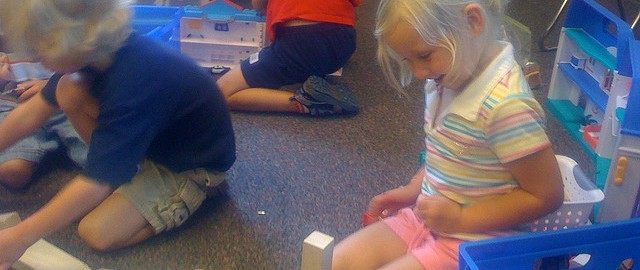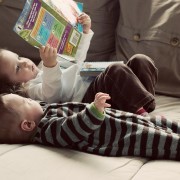Playing With Blocks
At 1, I taste the blocks, and throw them.
At 2, I stack them or line them up, noticing the edges of the blocks.
At 3, I build towers or trains, and can tell you about what I’ve made.
Blocks are one of those toys which last for years, and can be used in a variety of ways by children of many ages.
What types?
Blocks can be purchased sets of coloured wood, or interlocking plastic blocks, or they can be scraps of wood if you have friends who are builders. It’s good to start with non interlocking blocks – they are easier for little ones to attempt to stack.
Why are blocks so good? What do they do?
- They develop hand-eye co-ordination – the ability to position blocks on top of each other, so that they don’t topple over.
- Children learn to stack smaller blocks on top of larger ones.
- Stacking or lining up blocks helps children to learn about spatial relationships – this is important for later learning in Maths, and even reading (the spaces between words).
- It helps to develop concentration – whether it’s stacking carefully, or aligning them in a straight row.
- They help to develop creativity and imagination. You might think they’ve built a tower, but they tell you it’s a giant.
- Can encourage co-operative play: “Let’s build a city’ or ‘How about I use the green ones and you use the yellow ones?’
- It encourages problem solving eg how to rotate blocks to fit a space, or choosing the right sized block for the space.
- They also develop small and large muscle skills, in their hands and arms.
- Blocks may assist in learning colours eg ‘Can you build a yellow tower?’, or ‘Let’s get all the red and green blocks to make a train’.
Ideas…
- Many household items can be used for block play eg egg cartons, tissue boxes, shoe boxes, cereal containers.
- Play with blocks both inside and outside in the garden, or the sand pit.
- Give the child ‘props’ to expand their play eg twigs, rocks, small toy cars.
- Take photos of some of their creations to email to Grandma.
- You could collect a series of photos of the creations, and print them to make a small book – “Jasmine’s Creations” – put words to it, and read it with your child. Children love ownership like this.
- Build with your children, allowing them to decide what you do. Ask them: “What can Daddy build?” See what their imagination comes up with.
- Ask questions during play (not too many) eg “Where is this road going to?” or “Who lives in this tower?”
- Comment on their creations, using descriptive language eg : “That’s a very tall tower you’ve built.” or “I like the pattern of red and black blocks you’ve used.”
- Blocks can be stored in plastic crates, cardboard boxes, or old suitcases.
- If you are able to obtain wooden offcuts from a builder, show the children how to use sandpaper to make them smooth – they really enjoy doing this.
Happy Building!
—
Image by Anthony Crider via Flickr




